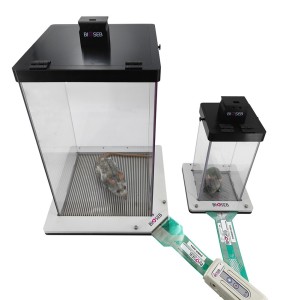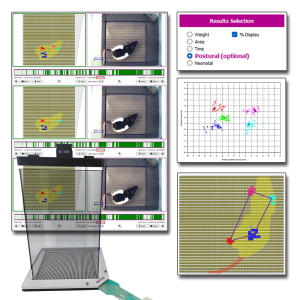Authors
L. Doré-Savard, V. Otis, K. Belleville, M. Lemire, M. Archambault et al.
Lab
Université de Sherbrooke, Department of Physiology and Biophysics, Sherbrooke, Canada.
Journal
PloS ONE
Abstract
Pre-clinical bone cancer pain models mimicking the human condition are required to respond to clinical realities. Breast or prostate cancer patients coping with bone metastases experience intractable pain, which affects their quality of life. Advanced monitoring is thus required to clarify bone cancer pain mechanisms and refine treatments. In our model of rat femoral mammary carcinoma MRMT-1 cell implantation, pain onset and tumor growth were monitored for 21 days. The surgical procedure performed without arthrotomy allowed recording of incidental pain in free-moving rats. Along with the gradual development of mechanical allodynia and hyperalgesia, behavioral signs of ambulatory pain were detected at day 14 by using a dynamic weight-bearing apparatus. Osteopenia was revealed from day 14 concomitantly with disorganization of the trabecular architecture (µCT). Bone metastases were visualized as early as day 8 by MRI (T(1)-Gd-DTPA) before pain detection. PET (Na(18)F) co-registration revealed intra-osseous activity, as determined by anatomical superimposition over MRI in accordance with osteoclastic hyperactivity (TRAP staining). Pain and bone destruction were aggravated with time. Bone remodeling was accompanied by c-Fos (spinal) and ATF3 (DRG) neuronal activation, sustained by astrocyte (GFAP) and microglia (Iba1) reactivity in lumbar spinal cord. Our animal model demonstrates the importance of simultaneously recording pain and tumor progression and will allow us to better characterize therapeutic strategies in the future.
BIOSEB Instruments Used
Dynamic Weight Bearing 2.0 (BIO-DWB-DUAL)
Source :
http://www.plosone.org/article/info%3Adoi%2F10.1371%2Fjournal.pone.0013774

 Pain - Thermal Allodynia / Hyperalgesia
Pain - Thermal Allodynia / Hyperalgesia Pain - Spontaneous Pain - Postural Deficit
Pain - Spontaneous Pain - Postural Deficit Pain - Mechanical Allodynia / Hyperalgesia
Pain - Mechanical Allodynia / Hyperalgesia Learning/Memory - Attention - Addiction
Learning/Memory - Attention - Addiction Physiology & Respiratory Research
Physiology & Respiratory Research











![Dynamic Weight Bearing 2.0 – Postural Module [Add-on]](https://bioseb.com/733-home_default/dynamic-weight-bearing-20-add-on-postural-module.jpg)
























 Pain
Pain Central Nervous System (CNS)
Central Nervous System (CNS) Neurodegeneration
Neurodegeneration Sensory system
Sensory system Motor control
Motor control Mood Disorders
Mood Disorders Other disorders
Other disorders Muscular system
Muscular system Joints
Joints Metabolism
Metabolism Cross-disciplinary subjects
Cross-disciplinary subjects CONFERENCES & MEETINGS
CONFERENCES & MEETINGS 
